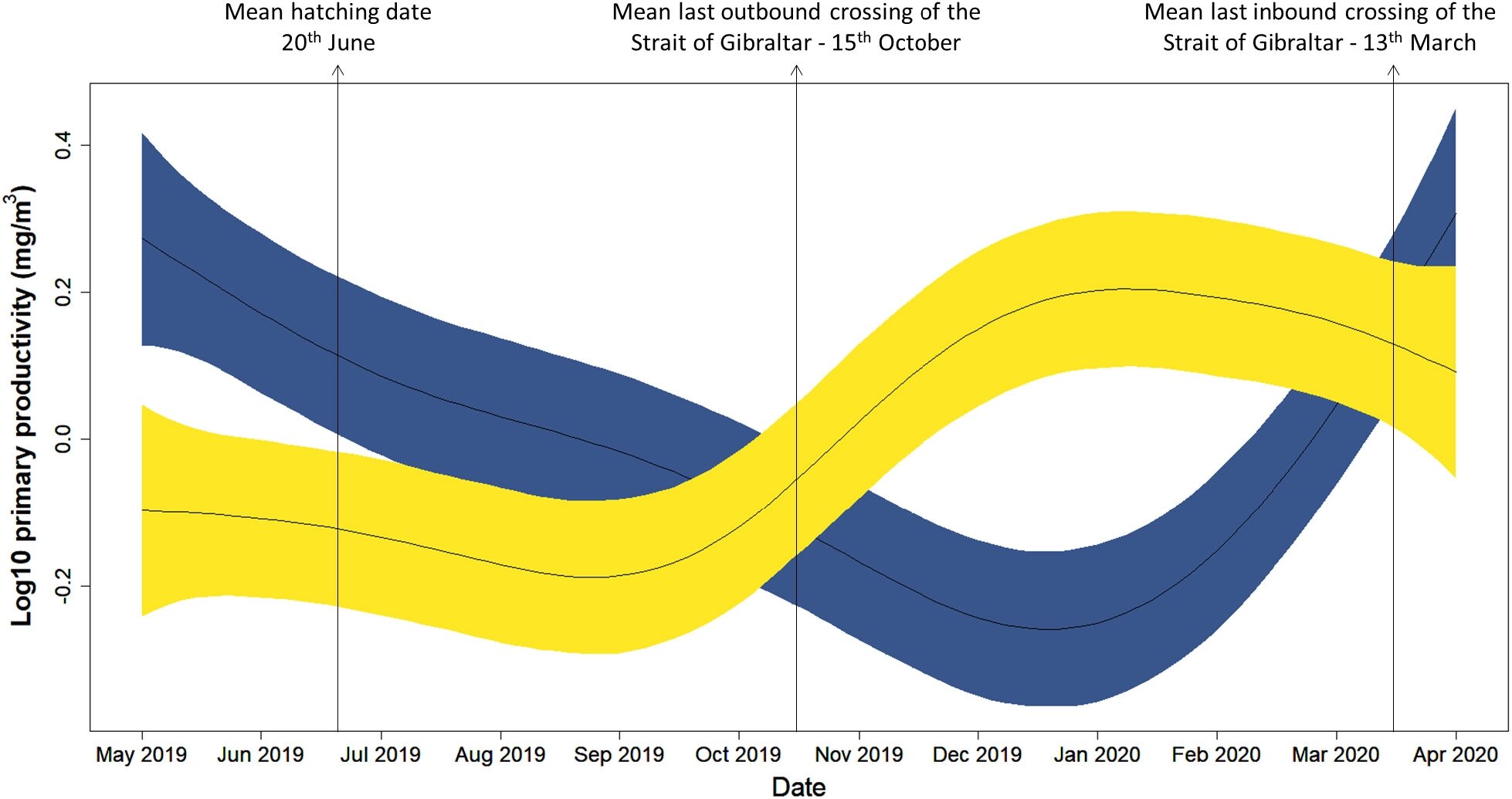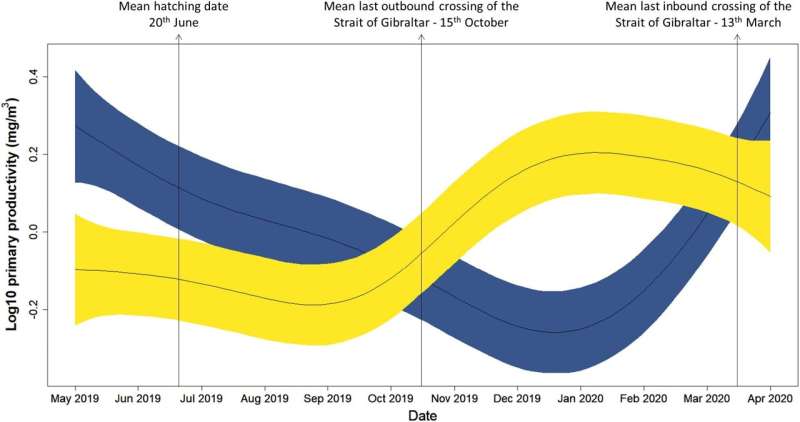

It had always been thought that the Mediterranean population of the European storm petrel —the smallest seabird in the Mediterranean—spent the year in this sea and that only a small part of the population migrated to the Atlantic during the winter season. Now, a study reveals that most of the European storm petrels that nest in the western Mediterranean move to the Atlantic Ocean as their main wintering area. The results, published in the International Journal of Avian Science (IBIS), contrast with the previously known migratory pattern in the central Mediterranean and outline a new migratory map for this small seabird.
The study was led by the researchers Raül Ramos and Teresa Militão, members of the Group on Seabird Ecology of the Faculty of Biology and the Biodiversity Research Institute of the University of Barcelona (IRBio-UB). Among the participants in the study were Ana Sanz-Aguilar and Andreu Rotger, from the University of the Balearic Islands and the Mediterranean Institute for Advanced Studies (IMEDEA, CSIC-UIB).
The smallest seabird in the Mediterranean basin
The European storm petrel (Hydrobates pelagicus) is a long-lived species with a low reproductive rate and a relatively late age of sexual maturity. Highly sensitive to threats affecting the adult survival, the bird only sets foot on land to breed. There are two subspecies: one that nests in the Mediterranean Sea (H. p. melitensis) and another, more abundant, that nests in several European islands of the Atlantic (H. p. pelagicus).
“Data from ring recoveries and open-sea sightings on board suggested that the Atlantic subspecies could migrate towards the southern waters of the African continent. In the Mediterranean subspecies, biogeochemical data and geolocation data indicated that most of the wintering took place in this sea,” says lecturer Raül Ramos, from the Department of Evolutionary Biology, Ecology and Environmental Sciences.
In the study, the team used light-level geolocators to infer the location of the Mediterranean population during a complete migratory cycle. Using these devices, placed on the birds’ tarsus (not on their backs with a harness, as usual until now), solar intensity was recorded for nearly a year. This methodology enabled the researchers to collect complementary data, such as saltwater conductivity and sea temperature.
“The results allow us to better understand the activity patterns of seabirds throughout the wintering season—i.e. when they fly and when they rest in the water—information that was previously unknown,” says researcher Teresa Militão, first author of the study.
“During the entire winter period, the species spends more time resting in the water during the day than at night. This tells us that the species forages mainly at night, and probably feeds on zooplankton and small fish that migrate to the sea surface at that time,” the researcher points out.
Heading for the North Atlantic waters
The main feeding areas of this species are still unknown. During the breeding period, it finds food in areas located at distances of up to 500 kilometers from the colony, according to other studies. During the rest of the year, “everything indicates that, in the case of the population studied, it feeds mainly in the Atlantic, in a marine area that extends from the Canary Islands to the south of Iceland,” the authors say. “The results contrast with the case of the Maltese storm petrel, which maintains its main wintering area in the central Mediterranean.”
Migratory species such as the European Storm petrel move periodically between distant areas to take better advantage of local resources or to find the most suitable habitat and climate at each stage of their life cycle. In the population this study analyzed, breeding adults return to the breeding colony between February and April to rejoin their partner and prepare for breeding. Between August and December, individuals leave the colony and begin postnuptial migration in a highly variable manner.
According to the collected geolocation data, the Atlantic Ocean would be the main wintering area for the European storm petrel that nests in the western Mediterranean. In particular, all the individuals that were tagged in 2018 and recaptured in 2019 wintered in the North Atlantic, a model that contrasts with the migratory pattern identified in the central Mediterranean.
“The extrinsic and intrinsic factors that determine the different migration patterns of the European storm petrel are still not well understood. According to the first results of the study, some extrinsic factors, such as oceanic conditions, could favor the migration of the population studied towards the North Atlantic, which would then take advantage of the productive oceanic waters during the wintering period,” says Raül Ramos.
The natal and breeding population also determines the migration patterns of each individual. There are also other intrinsic factors that cannot be ignored: genetic predisposition, age, physical condition, gender, reproductive success, molting status of feathers or physical condition, among others. That is why “we need more studies and data to understand the influence of all these factors on the migratory movements of the species,” note the authors.
Knowing the wintering areas in order to protect the species
The paper published in the journal IBIS improves our knowledge of the ecology of these birds and their distribution during their life cycle. “Knowing the wintering areas of this species will help to identify the environmental variables that condition its distribution,” say the authors.
Studies such as this one are crucial to understand the overlap between the areas explored by marine fauna and anthropogenic threats in the marine environment. “On land, during the breeding season, the European storm petrel is threatened by the introduction of invasive predators, such as cats or rats that prey on eggs… and by the destruction or modification of nesting habitats. In the open ocean, light pollution from ships or oil stations, climate change and extreme weather events such as cyclones or tornadoes also affect the survival of these small seabirds, which should be protected,” the researchers conclude.
Red-neck phalarope: a migratory divide towards the Pacific Ocean and the Arabian Sea
Teresa Militão et al, Non‐breeding distribution and at‐sea activity patterns of the smallest European seabird, the European Storm Petrel ( Hydrobates pelagicus ), Ibis (2022). DOI: 10.1111/ibi.13068
University of Barcelona
Citation:
Deciphering the migratory pattern of the smallest seabird in the Mediterranean (2022, June 7)
retrieved 7 June 2022
from https://phys.org/news/2022-06-deciphering-migratory-pattern-smallest-seabird.html
This document is subject to copyright. Apart from any fair dealing for the purpose of private study or research, no
part may be reproduced without the written permission. The content is provided for information purposes only.